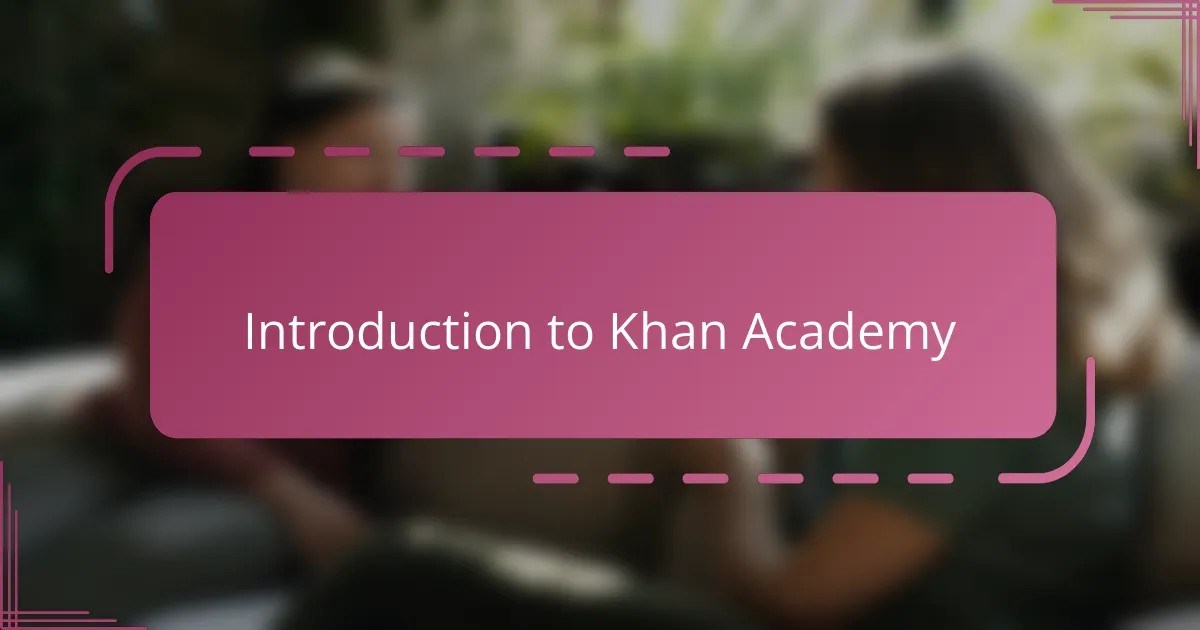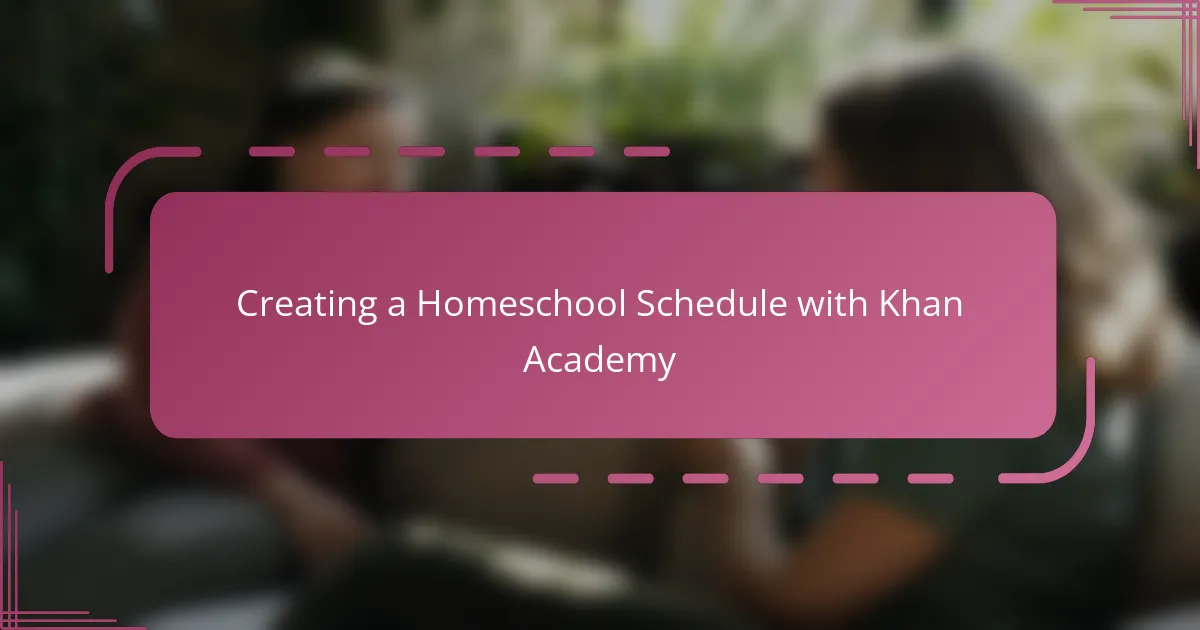Key takeaways
- Khan Academy allows children to learn at their own pace, reducing stress and promoting confidence through clear, digestible lessons.
- The platform includes progress tracking tools that help parents tailor lessons based on their child’s strengths and areas needing improvement.
- Incorporating Khan Academy into daily routines with short, focused sessions fosters engagement and maintains curiosity without overwhelming students.
- Engaging children with rewards, exploring topics together, and mixing subjects enhances their learning experience and keeps it fun.

Introduction to Khan Academy
Khan Academy is a treasure trove of free educational resources that I stumbled upon when looking for flexible homeschooling options. It offers lessons across a wide range of subjects, all crafted to be accessible and engaging for kids at different learning stages. Have you ever wished for a tool that adapts to your child’s pace without overwhelming them? That’s exactly what drew me to this platform.

Benefits of Khan Academy for Homeschooling
One of the biggest benefits I’ve found with Khan Academy is how it respects my child’s unique pace. Instead of rushing through topics or feeling stuck, my child can rewind videos and practice exercises until clarity sets in. Have you noticed how frustrating it can be when your child struggles but the curriculum keeps moving forward? Khan Academy’s flexibility has made learning less stressful and more enjoyable for both of us.
Another thing I appreciate is the way Khan Academy breaks down complex ideas into bite-sized, understandable chunks. It’s like having a patient tutor who explains things step by step without any judgment. This approach has boosted my child’s confidence, turning previously intimidating subjects into approachable challenges. Don’t you think confidence is half the battle when it comes to learning?
Finally, the data and progress tracking tools have been a game changer in my homeschooling journey. They give me clear insights into where my child excels and where extra help might be needed. This means I can tailor our daily lessons more effectively, ensuring no gaps go unnoticed. Have you ever wished for a way to track progress without slogging through endless paperwork? Khan Academy offers that peace of mind.

Setting Up Khan Academy for Your Child
Getting started with Khan Academy was surprisingly straightforward for me. I simply created a parent account and then set up a profile for my child, which felt like setting the stage for a new adventure in learning. Have you ever found that once you cross that initial tech hurdle, everything else falls into place more smoothly than expected?
What I found especially helpful was customizing the dashboard to focus on subjects that matched my child’s current interests and needs. It felt empowering to be able to guide their learning journey without forcing a rigid schedule. Don’t you think giving kids that kind of ownership can make a real difference in how they engage with their studies?
Also, linking Khan Academy with the mastery system meant I could check in on progress without constantly hovering over my child’s shoulder. It gave both of us a sense of independence—my child felt trusted, and I felt reassured. Isn’t it great when technology not only simplifies your role but also nurtures your child’s motivation?

Creating a Homeschool Schedule with Khan Academy
When I first created our homeschool schedule using Khan Academy, I realized that its structure naturally encouraged a balanced day. Instead of slotting in rigid hours, I let my child explore subjects in short, focused bursts, which kept enthusiasm high and eyes bright. Have you ever noticed how a strict timetable can sometimes kill curiosity? Khan Academy’s flexible pacing helped me avoid that.
Another thing I found valuable was how easily I could blend core academics with breaks and creative activities, thanks to the platform’s modular lessons. It felt like designing a custom roadmap where lessons could be paused, revisited, or accelerated without any fuss. Doesn’t that kind of freedom make the day feel less like a chore and more like an adventure?
I also appreciate that Khan Academy’s progress reports became my secret weapon in planning ahead. After a few weeks, I could see patterns emerge—areas where my child thrived and spots that needed extra attention. This allowed me to tweak our schedule by adding review sessions or switching up subjects to keep momentum going. Have you tried adjusting your homeschool routine based on data? It really transformed how productive and stress-free our days became.
![]()
Tracking Progress and Assessments
One of the features I rely on most with Khan Academy is the detailed progress tracking dashboard. It’s like having a clear map of my child’s learning journey laid out in front of me, showing which skills they’ve mastered and where they need more practice. Don’t you find it reassuring to have tangible proof of progress rather than just guessing how things are going?
What’s even better is how the platform uses quick quizzes and checkpoints to assess understanding in real time. I remember a time when my child struggled with a math concept, but the immediate feedback from these assessments helped us catch the problem early and address it right away. Have you ever wished for instant insight into your child’s grasp of a topic? That’s exactly what Khan Academy provides.
I also love how the mastery system encourages consistent review without feeling overwhelming. Seeing my child earn badges and level up has brought a surprising boost in motivation. It’s like turning assessment into a game, making tracking progress feel less like a chore and more like an accomplishment we celebrate together. Isn’t that the kind of positive reinforcement every homeschooler needs?

Incorporating Khan Academy into Daily Learning
Incorporating Khan Academy into our daily routine became easier once I treated it like a natural part of our day, rather than a separate subject to check off. I let my child choose a lesson that piques their interest each morning, which keeps motivation high and learning authentic. Have you noticed how kids engage more when they feel a bit of control over what they’re learning?
Rather than scheduling long sessions, we opt for short, focused activities with Khan Academy, blending videos and practice problems in manageable chunks. This approach stops overwhelm before it starts, making it easier to maintain consistency without burning out. I’ve found that this gentle rhythm keeps curiosity alive, even on days when energy feels low.
I rely heavily on the platform’s reminders and progress summaries to weave lessons seamlessly throughout the week. It’s comforting to know I have a built-in guide nudging us forward without me having to micromanage every step. Doesn’t that kind of support make homeschooling feel less like a juggling act and more like a shared adventure?

Tips for Engaging Your Child with Khan Academy
One thing I’ve learned is that making learning feel like play on Khan Academy really helps keep my child engaged. For example, I encourage small rewards for completing a set of exercises or mastering a topic, which adds an element of fun. Have you ever noticed how a little motivation can turn “homework” into something your child actually looks forward to?
I also set aside time to explore lessons together, especially when a topic seems tricky. Sitting alongside my child, asking questions, and celebrating small wins makes a huge difference—it turns screen time into quality time. Isn’t that connection what makes any learning experience truly meaningful?
Finally, I find it useful to mix subjects so the day doesn’t feel repetitive. Switching between math, science, and art lessons on Khan Academy keeps curiosity alive and prevents boredom. Have you tried letting your child pick a “wild card” lesson each day? It’s surprising how much excitement that little choice can spark.


